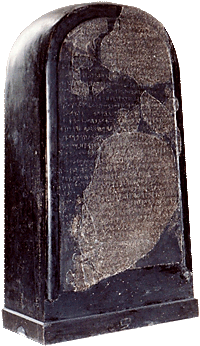What is the…
Moabite Stone
also known as: Mesha Stone or Mesha Stele

The Moabite Stone is an smooth ancient basalt stone, bearing an inscription by King Mesha, which was discovered at Dibon by Frederick Augustus Klein (F.A. Klein), a German missionary of Church Missionary Society (CMS) at Jerusalem, in 1868.
It was 3½ feet high and 2 in breadth and in thickness, rounded at the top. It consisted of thirty-four lines, written in Hebrew-Phoenician characters. It was set up by Mesha as a record and memorial of his victories. It records: (1) Mesha's wars with Omri, (2) his public buildings, and (3) his wars against Horonaim. This inscription in a remarkable degree supplements and corroborates the history of King Mesha recorded in 2 Kings 3:4-27.
With the exception of a very few variations, the Moabite language in which the inscription is written is identical with the Hebrew. The form of the letters here used supplies very important and interesting information regarding the history of the formation of the alphabet, as well as, incidentally, regarding the arts of civilized life of those times in the land of Moab.
This ancient monument, recording the heroic struggles of King Mesha with Omri and Ahab, was erected about 900 BC. Here “we have the identical slab on which the workmen of the old world carved the history of their own times, and from which the eye of their contemporaries read thousands of years ago the record of events of which they themselves had been the witnesses.”
At the time of its discovery, it was the oldest inscription written in alphabetic characters, and hence is—apart from its value in the domain of Hebrew antiquities—of great linguistic importance.
Appraisal by archaeologist and Bible scholar William F. Albright
“In the first place, no inscription of comparable age was then known, and it would, accordingly, have been impossible for the greatest scholar of the day to have divined the true forms of characters in use in the third quarter of the ninth century BCE… It is very easy to determine the exact state of knowledge at that time by examining Schroder’s handbook, Die phonizische Sprache, and Levy’s monograph, Siegel und Gemmen, both of which appeared in 1869. No lapidary Hebrew or Canaanite inscription antedating the sixth century (reign of Psammetichus II) was then known, aside from the still unintelligible Nora and Boss inscriptions and a few Old-Hebrew seals which could not then be dated at all.
Since the forms of characters changed rapidly between cir. 900 and cir. 590 BCE, there was thus no possible way of knowing what the alphabet of Mesha’s time might be.
Now we have many inscriptions dating from between cir. 850 and 750 BCE, some of which, like the nearly contemporary stele of Kilamuwa of Sham'al, the Hazael inscription from Arslan Tash, and the Ben-hadad stele, resemble the Mesha Stone very closely in script. Some of the forms of characters had not then been found in any documents. It was thus humanly impossible for the Mesha Stone to be forged.” —William F. Albright (1945)
More information
- Who is MESHA?
- What does the Moabite Stone reveal about the revolt of Mesha? Answer
- Chemosh
- Dibon
- Hebrew language
- Jehovah
- Kir-Haraseth
- Lachish
- What is MOAB?
- Moabite
- Omri
- Phenicia
- Archaeology and the Bible